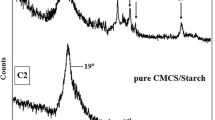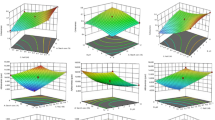Abstract
Projecting optimal composition for hydrogel blends, while designing sustained release formulation of hydrophilic drug, is of paramount importance. In present study, composite hydrogel incorporating ciprofloxacin (0.2% w/w) was prepared by sequential addition of polyvinyl alcohol (PVA) (20–95% w/w), starch (0–75% w/w), citric acid (5–80% w/w) as cross-linker in a heat-induced gelatinization process. A constrained simplex mixture design was adopted to rationalize the proportion of ingredients in hydrogel composition while modelling the time required for 50% drug release from the hydrogel under in-vitro conditions. Prepared hydrogels were also characterized for swelling ratio, tensile strength, and antimicrobial disc-diffusion assay. Decreasing proportion of starch relative to PVA results in a transparent hydrogel, with a high degree of equilibrium swelling (up to 104%). Drug release from all hydrogel blend arguably followed Korsmeyer-Peppas release kinetics with quasi-Fickian to non-Fickian release behaviour. The time required for 50% drug release and the hydrogel dissolution was proportional, indicating disintegration-controlled release rate. Reduced cubic-model based on the forward selection offered good agreement with experimental data (R2, 0.98 and adjusted R2 of 0.91). Optimal blend projection by the model with a mass ratio of 0.38:0.21:0.41 for PVA: Starch: citric acid was verified to be reasonably correct.








Similar content being viewed by others
References
Boateng J, Catanzano O (2015) Advanced Therapeutic Dressings for Effective Wound Healing—A Review. J Pharm Sci 104:3653–3680. https://doi.org/10.1002/jps.24610
Serra R, Grande R, Butrico L et al (2015) Chronic wound infections: the role of Pseudomonas aeruginosa and Staphylococcus aureus. Expert Rev Anti Infect Ther 13:605–613. https://doi.org/10.1586/14787210.2015.1023291
Roy DC, Tomblyn S, Burmeister DM et al (2015) Ciprofloxacin-Loaded Keratin Hydrogels Prevent Pseudomonas aeruginosa Infection and Support Healing in a Porcine Full-Thickness Excisional Wound. Adv Wound Care 4:457–468. https://doi.org/10.1089/wound.2014.0576
Liu X, Nielsen LH, Kłodzińska SN et al (2018) Ciprofloxacin-loaded sodium alginate/poly (lactic-co-glycolic acid) electrospun fibrous mats for wound healing. Eur J Pharm Biopharm 123:42–49. https://doi.org/10.1016/j.ejpb.2017.11.004
Unnithan AR, Barakat NAM, Tirupathi Pichiah PB et al (2012) Wound-dressing materials with antibacterial activity from electrospun polyurethane–dextran nanofiber mats containing ciprofloxacin HCl. Carbohydr Polym 90:1786–1793. https://doi.org/10.1016/j.carbpol.2012.07.071
Vermeulen H, Ubbink DT, de Zwart F et al (2007) Preferences of patients, doctors, and nurses regarding wound dressing characteristics: A conjoint analysis. Wound Repair Regen 15:302–307. https://doi.org/10.1111/j.1524-475X.2007.00230.x
Fu Y, Kao WJ (2010) Drug release kinetics and transport mechanisms of non-degradable and degradable polymeric delivery systems. Expert Opin Drug Deliv 7:429–444. https://doi.org/10.1517/17425241003602259
Peppas NA (2000) Hydrogels in pharmaceutical formulations. Eur J Pharm Biopharm 50:27–46. https://doi.org/10.1016/S0939-6411(00)00090-4
Jiang S, Liu S, Feng W (2011) PVA hydrogel properties for biomedical application. J Mech Behav Biomed Mater 4:1228–1233. https://doi.org/10.1016/j.jmbbm.2011.04.005
Shitole AA, Raut PW, Khandwekar A et al (2019) Design and engineering of polyvinyl alcohol based biomimetic hydrogels for wound healing and repair. J Polym Res 26:201. https://doi.org/10.1007/s10965-019-1874-6
Hoffman AS (2012) Hydrogels for biomedical applications. Adv Drug Deliv Rev 64:18–23. https://doi.org/10.1016/J.ADDR.2012.09.010
Hoare TR, Kohane DS (2008) Hydrogels in drug delivery: Progress and challenges. Polymer (Guildf) 49:1993–2007. https://doi.org/10.1016/J.POLYMER.2008.01.027
Bajpai SK, Sonkusley J (2002) Hydrogels for oral drug delivery of peptides: Synthesis and characterization. J Appl Polym Sci 83:1717–1729. https://doi.org/10.1002/app.10097
Tang X, Alavi S (2011) Recent advances in starch, polyvinyl alcohol based polymer blends, nanocomposites and their biodegradability. Carbohydr Polym 85:7–16. https://doi.org/10.1016/J.CARBPOL.2011.01.030
Ibrahim MM, El-Zawawy WK, Nassar MA (2010) Synthesis and characterization of polyvinyl alcohol/nanospherical cellulose particle films. Carbohydr Polym 79:694–699. https://doi.org/10.1016/J.CARBPOL.2009.09.030
Sinha Ray S, Bousmina M (2005) Biodegradable polymers and their layered silicate nanocomposites: In greening the 21st century materials world. Prog Mater Sci 50:962–1079. https://doi.org/10.1016/J.PMATSCI.2005.05.002
Majdzadeh-Ardakani K, Nazari B (2010) Improving the mechanical properties of thermoplastic starch/poly(vinyl alcohol)/clay nanocomposites. Compos Sci Technol 70:1557–1563. https://doi.org/10.1016/j.compscitech.2010.05.022
Liu Q, Chen N, Bai S, Li W (2018) Effect of silver nitrate on the thermal processability of poly(vinyl alcohol) modified by water. RSC Adv 8:2804–2810. https://doi.org/10.1039/C7RA12941F
Bueno VB, Bentini R, Catalani LH, Petri DFS (2013) Synthesis and swelling behavior of xanthan-based hydrogels. Carbohydr Polym 92:1091–1099. https://doi.org/10.1016/j.carbpol.2012.10.062
Shi R, Bi J, Zhang Z et al (2008) The effect of citric acid on the structural properties and cytotoxicity of the polyvinyl alcohol/starch films when molding at high temperature. Carbohydr Polym 74:763–770. https://doi.org/10.1016/j.carbpol.2008.04.045
Park H-R, Chough S-H, Yun Y-H, Yoon S-D (2005) Properties of Starch/PVA Blend Films Containing Citric Acid as Additive. J Polym Environ 13:375–382. https://doi.org/10.1007/s10924-005-5532-1
Das A, Uppaluri R, Das C (2019) Feasibility of poly-vinyl alcohol/starch/glycerol/citric acid composite films for wound dressing applications. Int J Biol Macromol 131:998–1007. https://doi.org/10.1016/j.ijbiomac.2019.03.160
Ounkaew A, Kasemsiri P, Kamwilaisak K et al (2018) Polyvinyl Alcohol (PVA)/Starch Bioactive Packaging Film Enriched with Antioxidants from Spent Coffee Ground and Citric Acid. J Polym Environ 26:3762–3772. https://doi.org/10.1007/s10924-018-1254-z
Wu Z, Wu J, Peng T et al (2017) Preparation and Application of Starch/Polyvinyl Alcohol/Citric Acid Ternary Blend Antimicrobial Functional Food Packaging Films. Polymers (Basel) 9:102. https://doi.org/10.3390/polym9030102
Chin SF, Romainor ANB, Pang SC, Lihan S (2019) Antimicrobial starch-citrate hydrogel for potential applications as drug delivery carriers. J Drug Deliv Sci Technol 54:101239. https://doi.org/10.1016/j.jddst.2019.101239
Sridach W, Jonjankiat S, Wittaya T (2013) Effect of citric acid, PVOH, and starch ratio on the properties of cross-linked poly(vinyl alcohol)/starch adhesives. J Adhes Sci Technol 27:1727–1738. https://doi.org/10.1080/01694243.2012.753394
Laçin NT (2014) Development of biodegradable antibacterial cellulose based hydrogel membranes for wound healing. Int J Biol Macromol 67:22–27. https://doi.org/10.1016/j.ijbiomac.2014.03.003
Bagri LP, Bajpai J, Bajpai AK (2011) Evaluation of starch based cryogels as potential biomaterials for controlled release of antibiotic drugs. Bull Mater Sci 34:1739–1748. https://doi.org/10.1007/s12034-011-0385-9
Korsmeyer RW, Gurny R, Doelker E et al (1983) Mechanisms of solute release from porous hydrophilic polymers. Int J Pharm 15:25–35. https://doi.org/10.1016/0378-5173(83)90064-9
Higuchi T (1963) Mechanism of sustained-action medication. Theoretical analysis of rate of release of solid drugs dispersed in solid matrices. J Pharm Sci 52:1145–1149. https://doi.org/10.1002/jps.2600521210
Dash S, Murthy PN, Nath L, Chowdhury P (2010) Kinetic modeling on drug release from controlled drug delivery systems. Acta Pol Pharm 67:217–223
Mabrouk M, Mostafa AA, Oudadesse H et al (2014) Effect of ciprofloxacin incorporation in PVA and PVA bioactive glass composite scaffolds. Ceram Int 40:4833–4845. https://doi.org/10.1016/j.ceramint.2013.09.033
Pal K, Banthia AK, Majumdar DK (2008) Effect of heat treatment of starch on the properties of the starch hydrogels. Mater Lett 62:215–218. https://doi.org/10.1016/j.matlet.2007.04.113
Zou G-X, Qu J-P, Zou X-L (2007) Optimization of water absorption of starch/PVA composites. Polym Compos 28:674–679. https://doi.org/10.1002/pc.20333
Ghorpade VS, Dias RJ, Mali KK, Mulla SI (2019) Citric acid crosslinked carboxymethylcellulose-polyvinyl alcohol hydrogel films for extended release of water soluble basic drugs. J Drug Deliv Sci Technol 52:421–430. https://doi.org/10.1016/j.jddst.2019.05.013
Zhou X-H, Wei D-X, Ye H-M et al (2016) Development of poly(vinyl alcohol) porous scaffold with high strength and well ciprofloxacin release efficiency. Mater Sci Eng C 67:326–335. https://doi.org/10.1016/j.msec.2016.05.030
Sreedhar B, Sairam M, Chattopadhyay DK et al (2005) Thermal, mechanical, and surface characterization of starch-poly(vinyl alcohol) blends and borax-crosslinked films. J Appl Polym Sci 96:1313–1322. https://doi.org/10.1002/app.21439
Xu F, Lu T (2011) Experimental Characterization of Skin Biothermomechanics. Introduction to Skin Biothermomechanics and Thermal Pain. Springer, Berlin Heidelberg, Berlin, Heidelberg, pp 267–323
Mahdavinia GR, Karimi MH, Soltaniniya M, Massoumi B (2019) In vitro evaluation of sustained ciprofloxacin release from κ-carrageenan-crosslinked chitosan/hydroxyapatite hydrogel nanocomposites. Int J Biol Macromol 126:443–453. https://doi.org/10.1016/j.ijbiomac.2018.12.240
Ounkaew A, Kasemsiri P, Jetsrisuparb K et al (2020) Synthesis of nanocomposite hydrogel based carboxymethyl starch/polyvinyl alcohol/nanosilver for biomedical materials. Carbohydr Polym 248:116767. https://doi.org/10.1016/j.carbpol.2020.116767
Uliniuc A, Hamaide T, Popa M, Băcăiță S (2013) Modified Starch-Based Hydrogels Cross-Linked with Citric Acid and their use as Drug Delivery Systems for Levofloxacin. Soft Mater 11:483–493. https://doi.org/10.1080/1539445X.2012.710698
Marani PL, Bloisi GD, Petri DFS (2015) Hydroxypropylmethyl cellulose films crosslinked with citric acid for control release of nicotine. Cellulose 22:3907–3918. https://doi.org/10.1007/s10570-015-0757-1
Negi P, Singh B, Sharma G et al (2016) Phospholipid microemulsion-based hydrogel for enhanced topical delivery of lidocaine and prilocaine: QbD-based development and evaluation. Drug Deliv 23:941–957. https://doi.org/10.3109/10717544.2014.923067
Pang SC, Chin SF, Tay SH, Tchong FM (2011) Starch–maleate–polyvinyl alcohol hydrogels with controllable swelling behaviors. Carbohydr Polym 84:424–429. https://doi.org/10.1016/j.carbpol.2010.12.002
Author information
Authors and Affiliations
Corresponding author
Ethics declarations
Conflicts of interest
There is no conflict of interest to declare.
Additional information
Publisher’s Note
Springer Nature remains neutral with regard to jurisdictional claims in published maps and institutional affiliations.
Electronic supplementary material
Below is the link to the electronic supplementary material.
Rights and permissions
About this article
Cite this article
David, J., Mahanty, B. Optimized ciprofloxacin release from citric acid crosslinked starch-PVA hydrogel film: modelling with mixture design. J Polym Res 28, 20 (2021). https://doi.org/10.1007/s10965-020-02397-7
Received:
Accepted:
Published:
DOI: https://doi.org/10.1007/s10965-020-02397-7




